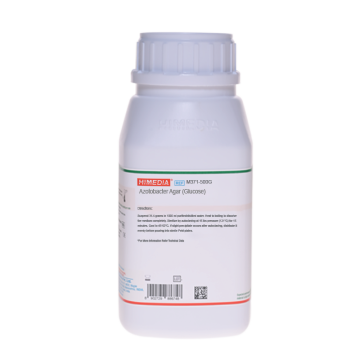 Your enquiry has been submitted
Your enquiry has been submitted
Azospirillum Medium w/o Agar (Twin Pack)
Intended Use
Azospirillum Medium w/o agar is used for cultivation of Azospirillum species.
Composition**
| Ingredients | Gms / Litre |
|---|---|
| Part A: | |
| Malic acid | 5.000 |
| Dipotassium phosphate | 0.500 |
| Ferrous sulphate | 0.500 |
| Manganese sulphate | 0.010 |
| Magnesium sulphate | 0.200 |
| Sodium chloride | 0.100 |
| Bromo thymol blue | 0.002 |
| Sodium molybdate | 0.002 |
| Calcium chloride | 0.020 |
| Part B: | |
| Potassium hydroxide | 4.000 |
Final pH ( at 25°C): 6.8±0.2
**Formula adjusted, standardized to suit performance parameters
Directions
Suspend 6.33 grams in 950 ml distilled water. Heat if necessary to dissolve the medium completely. Sterilize by autoclaving at 15 lbs pressure (121°C) for 15 minutes. Cool to room temperature and slowly add 50 ml of sterile Part B prepared by adding 1.30 grams -1.50 grams of Potassium hydroxide to 50 ml of sterile distilled water.
Principle And Interpretation
Azospirilla are generally gram-negative rods which are motile by means of a single flagellum. Azospirilla are also capable of fixing nitrogen (1). The cells of Azospirillum remain in association with the roots and fix part of the atmospheric nitrogen. Azospirillum species may be isolated from rhizosphere biofilms associated with the roots of various grasses, cereals, and tuber plants. Their isolation is based on the fact that these organisms can grow in concentrations of nitrogen too low to support growth of most microorganisms. Azospirillum cultures are useful for the cereals and cash crops viz. wheat, paddy, bajra, jowar, maize, mustard, cotton, cumin, banana, sugarcane, tobacco, castor, vegetables etc., as well as horticultural crops. Both in greenhouse and in field trials, several strains of Azospirillum have been shown to exert beneficial effects on plant growth and crop yields, under various soil and climatic conditions, and are thus qualified as Plant Growth-Promoting Rhizobacteria (PGPR) (2).
This medium contains malic acid which serves as the prime carbon source. Azospirillum species grow well in presence of malic acid and are not overgrown by other nitrogen fixers. Dipotassium phosphate provides buffering effect. Necessary trace elements like ferrous sulphate, manganese sulphate, sodium molybdate supports growth of Azospirillum species. Divalent salts like calcium and magnesium helps metabolism of cells. Sodium chloride helps to maintain osmotic balance of cell.
Quality Control
Appearance: Part A : Cream to yellow homogeneous free flowing powder Part B :White to cream pellets
Colour and Clarity of prepared medium: Light yellow coloured clear to slightly opalescent solution
Reaction: Reaction of 0.63% w/v aqueous solution at 25°C. pH : 6.8±0.2
pH: 6.60-7.00
Cultural Response: Cultural characteristics observed after an incubation at 25-30°C for upto 8 days .
| Organism | Growth |
|---|---|
| Azospirillium brasilense ATCC 29710 | luxuriant |
Storage and Shelf Life
Store below 30°C in tightly closed container and the prepared medium at 2 – 8°C. Use before expiry date on the label.
Reference
- Bergey's Manual of Systematic Bacteriology (1984), Vol. 1, Pg. 100-103. Kreig NR and Holt JG (eds.), Williams and Wilkins, London.
- Genoscope, 15 Jan 2008.
| Product Name | Azospirillum Medium w/o Agar (Twin Pack) |
|---|---|
| SKU | M1720 |
| Product Type | Regular |
| Physical Form | Powder |
| Origin | Chemically defined |
| Packaging type | HDPE |
| References | 1. Bergey's Manual of Systematic Bacteriology (1984), Vol. 1, Pg. 100-10 |
| Customized Product Available | No |







